 "Let me return to my old primary school, St Joseph's convent [in Cloncurry]. Saint Mary McKillop, I'm sure, was just like my principal, Sister Thomas..." Bob Katter's book, while retrieving some good Australian ideas and paying its respects to our ancestors, also markets big population ideas uncannily like those of B.A. Santamaria.
"Let me return to my old primary school, St Joseph's convent [in Cloncurry]. Saint Mary McKillop, I'm sure, was just like my principal, Sister Thomas..." Bob Katter's book, while retrieving some good Australian ideas and paying its respects to our ancestors, also markets big population ideas uncannily like those of B.A. Santamaria.
Bob Katter An Incredible Race of People Murdoch Books, September 13, 2012.
Down the rabbit hole
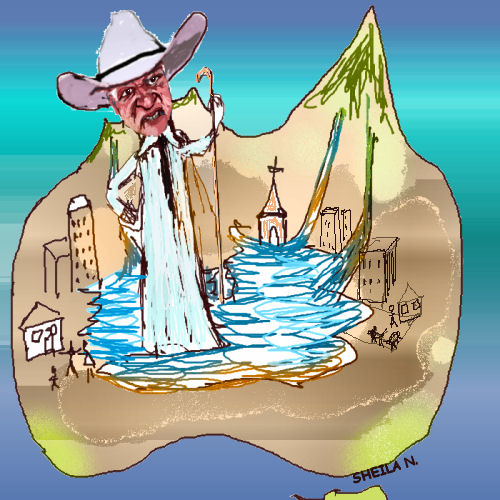
Hurrying through a mall in outer Brisbane, a few weeks ago a book by outback Queensland independent politician, Bob Katter Jr., caught my eye amongst the fat-foodie and ‘life-changing’ array in the bookshop. It was strangely alluring like the rabbit hole for Alice.
A friend and I found it so fascinating in its chronicle from a particular point of view of Australian political and economic history that we bought two copies; one for kindle and the other a hardback, so that we could compare notes.
Even so, this book review was very hard to write. Katter’s book reflects a long lifetime of quirky political observations and experience in a head-long rush of a narrative, opinion and anecdote. It is a long and detailed book. Even if you disagree with every word, it is hard to dislike the enthusiasm and overt individuality, so rare in an Australian politician.
Surprisingly, I found it easiest to start by comparing Katter’s book with professional journalist Laura Tingle’s article, “Great Expectations”, in Quarterly Essay recently. See [See "Tingle shoots blanks ..."]
Tingle dumbfounds in her strangely arrogant and unempathic painting of Australian convicts as wimps and whiners, and the Australian population as curiously dependent, whereas Katter writes warmly of an 'incredible race of people' who came from the "convict crucible".
Katter performs an educational service in telling of all the things that Australians managed to create and do with a population of only about 7 million - proportionately more than we now achieve in manufacture. But he seems not to realise the contradiction between his acknowledgement of how well we achieved and what we created at 7 million and his current perception that we now need a much bigger population. In fact, in his last two chapters, he puts on the growth spurs and urges for a population of 55 million by ... wait for it... 2037! That's in 24 years. One generation. An immigration invasion, no less.
Katter is a self-confessed 'developmentalist'. He admires 'doers' and despises ‘pygmyism’ [what he perceives as the opposite of developmentalism]. His whole book is a hymn to engineering, peasant farming, empire building and … did I say? … population growth.
The son of a Cloncurry Labor Party secretary, Katter seems to be a B.A. Santamariarist (a Grouper) at heart in his desire to irrigate the Australian desert and settle tens of millions of peasant farmers there. You wonder why and, in the very last chapter, you realise that he is the product of a Catholic education and the associated ideology about civilization as a moral imperative, medical science as having saved us from an eternal struggle against pestilence and disease, without which one in four would not survive birth, [1] and that population growth is normal or good. Despite all his lauding of the 'first Australians', he is a fan of the 'civilising' influence of the Conquistador.
"Let me return to my old primary school, St Joseph's convent [in Cloncurry]. Saint Mary McKillop, I'm sure, was just like my principal, Sister Thomas..."
Katter's values shape the things he chooses as important in history. It makes sense to compare Katter with Tingle because both use quite different interpretations of the same events to kick off opposite ideologies. Tingle uses the history of politicians selling off our institutions to argue that we can no longer expect anything of governments. Katter uses a different interpretation of the same thing to argue for the election of his party of 'doers' to bring back those lost empowering institutions - like a Peoples' Bank, patriotic Australian employers, Australian manufacturing and design, and an owner–operator society, in which men sell their labour or their produce through collectively owned ‘means of production’, or at least through statutory collective marketing arrangements.[2] Many Australians would welcome these among Katter’s policies.
Tingle mentions how Australia has been subject to constant mass immigration. She then glaringly omits to comment on this. Katter can hardly stop talking about it. He wants more, more, MORE!
Most Australians don’t want a bigger population.
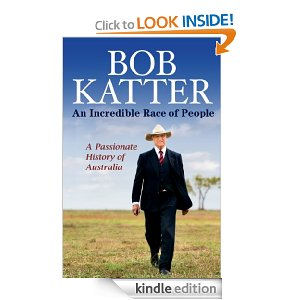
Katter’s dream
What is to underpin Katter's vision of turning of rivers inland and the flooding of the interior with water to create an inland sea for a hugely swollen population? Katter believes that almost limitless coal resources underlie about 20 per cent of Queensland. In fact he believes that Australia has the most coal of any country in the world. (Usually Australia is placed around third in coal reserves globally). He actually believes that Australia can be a great power just on these, with 'clean coal technology' [3] and ethanol from sugar cane. These energy sources combined with massive irrigation throughout much of Australia, for Katter would enable a host of peasant farms across northern Australia, to feed the world and power Australian industry and huge new cities in the north and south, plus our current cities ballooned to megapolises.
Creating an inland sea, if you added trees (which Katter does not mention) might affect climate positively, although this is an old idea which has been criticized as unlikely to do what it purports, and of a scale so financially costly that no government has ever gone further than look at the idea and hastily discard it.[4] If our population stayed the same, in theory such a scheme might help our current environmental problems, however, Katter simply wants to use it to add to our problems by turbo-charging immigration. So we would have massive increased energy costs associated with a vast engineering scheme, plus all the additional costs of the new population. Katter, however, only assesses things in terms of a credit side to an imaginary financial balance sheet. He just doesn’t get that the financial balance sheet depends on the health of the environment and that we are already overpopulated. Or, maybe he does get it but he knows that he is more likely to get coverage in the mainstream press and funding if he makes an appeal to the big populationists of corporate Australia.
Population and scale
Katter believes that big populations carry ‘economies of scale’. He seems not to have heard about the diseconomies of scale we are all experiencing with congestion in Australian cities. Nor does he seem to notice the loss of democratic representation as our representatives preside at a great altitude over more and more vast electorates in a materialistic hierarchy antithetical to the Australian egalitarianism that Katter also extols. His answer to our overlarge population’s overshoot of Australia’s water supply is to turn the northern rivers inland. Katter is the kind of man who cannot acknowledge limits. (In this he is no different from nearly every Australian politician).
He thinks that Australia can return to farming and manufacturing and inventing with
"[...] an extra 100,000 migrants a year [...adding] to the current immigration mix of 250,000 a year, giving us a population by 2037 that would be in line with most countries: around 55 million."
Yet he began his book saying how much we manufactured with only 7 million people. He also notes how successive economic liberalization policies put Australian business out of business and promoted international corporations. It seems to me that, if we changed our anti [small and medium] -business laws, our enterprise would again flourish, probably better without the constant pressure on land and resources prices of a bigger population.
He does not explain how he arrives at a definition of 'most countries' nor why we would aim to be of a particular [big] size. If you look up countries with populations over 30m but less than 100m you get: Philippines, Vietnam, Germany, Ethiopia, Egypt, Iran, Turkey, Congo Democratic Republic, France, Thailand, United Kingdom, Italy, Myanmar, South Korea, South Africa, Spain, Ukraine, Colombia, Tanzania, Argentina, Kenya, Sudan, Poland, Algeria, Canada, Uganda, and Morocco. The list of countries with much smaller populations than that is much longer and includes Switzerland, Sweden, Israel, Hong Kong, Singapore, Denmark, Ireland, Finland, New Zealand, Norway, Taiwan, Australia, Syria, Romania, Netherlands, Greece, Belgium, Portugal, Czech Republic, Hungary, Iraq, Venezuela, Malaysia, Saudi Arabia, and more...
Hydraulic engineering
In his barracking for a huge population for Australia, Katter is also calling for increased irrigation and the canalization of Australia's waterways on an unprecedented scale. He completely ignores wild ecology, animal rights, and the right of people to have wilderness. He celebrates as worthwhile the activities of engineering, road building, dam building, and irrigation channel building above all.
He is like a man in the grip of an ecstatic vision driving at 200 kpm down a highway in the middle of the night without any lights on, with no brakes and no insurance. In this he seems to be exactly like nearly every other politician in the country – except that he remains interested in primary products.
"Our mining product, our beef and our ethanol would be carried out on great canals fanning in from Spencer Gulf and south from [...] Two per cent of northern Asutralia's land and just 7 per cent of its water, combined with 10 per cent of Australia's grain [...] a real, open and sensible migration system. It will be unlike our current migration system that chokes off people [...] Some of this new population and much of the old will have moved out of rabbit-warren cities and onto their own one to three [...] A population of that size will provide great prosperity and great economies of scale. [...] All of northern Australia will become 'the land of 10,000 billabongs', with wildlife and nature no longer struggling [...]
Catholic education negates sensitivity to nature?
Note that this last statement is the only one that sounds even faintly kindly towards our natural environment. My impression was that Katter's catholic education probably taught him to block nature out, in the belief that endless human expansion was our manifest destiny. For Katter, science is not about understanding and cooperating with our wonderful natural world; it is about dominating it and subduing it. And that means dominating and subduing local senses of place and local empowerment with massive engineering projects and mass immigration, for all his talk about democracy.
Whilst one can understand his position as a representative for farming influencing his perception of engineering rivers and dams, he actually seems to be irrigation and production- mad, to the extent that there can never be enough! For this reason (as well as the extraordinary financial and engineering costs and poor chances of success), one cannot endorse his wish to revive the Bradfield Scheme to water Australia's inland deserts, leaving the rest of Australia trashed and going forth to multiply and trash the rest.
(For a dissection of the Bradfield scheme and its paroxysmal resurgence from time to time in Australia, see, Dr Robert Wooding, "Populate, parch and panic: two centuries of dreaming about nation-building in inland Australia," Chapter 6 of John Butcher (Ed.), Australia under construction : nation-building : past, present and future, ANU School of Government, 2008.] [For a discussion of the Australian tendency to big huge and costly projects of little real benefit, see, Dr Richard Evans' "A passion for white elephants: some lessons from Australia’s experience of nation building" in Chapter 5 of John Butcher (Ed.), Australia under construction : nation-building : past, present and future, ANU School of Government, 2008.)
Aboriginal Land and Water
For Katter, private property is the key to civilisation. Unfortunately he is unable to see that modern economics in Australia also has a downside in its zero-sum capitalisation of land.
Convinced of the British capitalist system as the way forward, Katter thinks that Aboriginal land should be alienable - that is, that Aborigines should be able to buy and sell their community land - principally in order to borrow from banks so as to start businesses.
"It should appear obvious to any objective social commentator or historian that the often portrayed ugly picture of ‘Aboriginal’ Australia would be exactly the same picture in every town, village and city in the rest of Australia if the inhabitants were suddenly bereft of the private ownership of land and realty, and all that land and realty was suddenly to belong to the so-called ‘community’." (Jnr, Bob Katter (2012-05-15). An Incredible Race of People (Kindle Locations 714-716). Murdoch Books Australia. Kindle Edition.)
He is right, of course, as far as his philosophy goes, but it doesn’t go very far. The problem is that all that privately-owned land and realty is exponentially gravitating to fewer and fewer hands because of our 'wonderful' land-tenure system, so that the majority of Australians are becoming increasingly land and capital poor and endebted. What is the point in turning Aboriginal land into this economic quicksand?
Equity is preserved far better in the European roman law or Napoleonic system, but Katter, like most Anglophone politicians does not know of this alternative system that almost every country in Europe uses. (Pity, because he might like French dirigism and he might learn something from a system that counts population growth as costs to the community.) Aboriginal land as the founding institution of their 60,000 year old society has a much better record than a 300 year old capitalism that is cannibalising its own people and their property. Try taking Maori land away! No-one would dare to suggest that as a good idea.
Katter damns the Queensland Labor Government for reversing attempts to privatise Aboriginal land. Basically he believes in 'progress' as an evolutionary and divinely inspired constant. He does not seem to appreciate (and it does not seem to occur to him) that the Australian Aboriginal way of life retains its intrinsic validity, any more than he seems to appreciate the intrinsic validity (or value) of nature itself without the imprint of industrial man. Even though he describes gallantly the stand that the Australian Aborigines made against the British invasion, one can see that he feels it is all in the past, in a time unredeemed by Progress, Catholicism, mining and irrigation.
He also cannot stand to see all that water in the north under native title.
Ethanol and Carbon Emissions
Inspired by the Brazilian ethanol industry, Katter promotes the idea that carbon emissions will be taken care of by the production of ethanol from sugar cane, which can be substituted for petroleum. The next sugar cane crop will reabsorb the carbon emissions, he believes. Although he is a rural politician, he has a strange disregard for soil.
The main problem with the production of biofuels from crops is the overuse of soil, which is biologically alive. The constituent soil organisms cannot survive frequent mechanical disturbance and applications of rich fertilizers, which is what is required for the production of monocrops. Another problem is the great amount of water necessary to grow the crops and create the fuel. Use of diesel fuel for mechanical operations, especially at farm level, detracts from the ultimate net energy production and from the ultimate net CO2 production. (It is true that the latter would be zero if it were not for the use of fossil fuels in production.)
Brazilian scientists have costed their ethanol industry:
“…the production of 1 liter of ethanol from sugarcane requires approximately 18.4 l of water, 0,07 kg of crude oil equivalent, and 1.52 m2 of annual land use and results in the lost of 1.8 kg of soil due to erosion. These results are impressive, especially when the Brazilian ethanol production, 16 billion of liters in 2006 (Brazil, 2007) is considered. The soil lost is of utmost importance since the ability in growing sugarcane to ethanol production, or any other crop, is directly related to this natural non-renewable resource.” Source: Consuelo L. F. Pereira and Enrique Ortega, 2005. “Sustainability Assessment of Ethanol Production from Sugarcane,” Conference Paper, , http://www.advancesincleanerproduction.net/first/textos%20e%20arquivos/sessoes/4a/1/Consuelo%20Fernandez%20Pereira%20-%20Resumo%20Exp..doc
“Although the popular belief that ethanol systems have no net CO2 emissions, they do have because of direct and indirect oil consumption; this system uses external inputs that demand petroleum in their production: fertilizers, equipments, chemical inputs, infra-structure and so on. Our estimate is that there is a release of 0.29 kg of CO2 per liter of ethanol produced.” Source: Source: Consuelo L. F. Pereira and Enrique Ortega, 2005. “Sustainability Assessment of Ethanol Production from Sugarcane,” Conference Paper,
http://www.advancesincleanerproduction.net/first/textos%20e%20arquivos/sessoes/4a/1/Consuelo%20Fernandez%20Pereira%20-%20Resumo%20Exp..doc
To summarise the above: There is no such thing as a free lunch; the transformation of one energy form to another costs. A lot. We are using giant fossil fuel oil reserves. When they are gone we won’t be able to replace them with anything even remotely so vast. Trying to do so with sugarcane is a wet dream.
Loaves and fishes mentality
Katter expresses religio-economic beliefs in the value of capitalism and a notion of 'progress' similar to those of most parliamentarians today. This makes him argue like an ecological and thermodynamic simpleton about economies of scale with an increased population when we are looking at fossil fuel resource depletion and cannot cope with the pollution and emissions fall-out from what he have already used. Confident as a brave hunter that there will always be something out there to spear, he sounds like too much of a Man to carry a dilly bag or stop to clean up the mess before inviting 35 million more people along to the barbecue.
As a "Developmentalist" much of his economic philosophy is founded on the Keynesian way out of the Great Depression, when, in an age of cheap oil, governments poured money into projects to employ their people to build infrastructure for future manufacture and expansion. Reasonable for that era, but not for ours. The circumstances have changed.
His hero, Ted Theodore, who built the Australian Workers Union up, was Premier of Queensland from 1919 to 1925, a member of the federal House of Representatives from 1927 to 1931, and Federal Treasurer from 1929 to 1930, was a champion of the Keynesian approach, but was not able to get support to implement it, due to a political scandal.
Katter’s opus is peppered with positive delivery of the kinds of statements that give ecologists and enlightened farmers the willies, such as:
"Les Thiess had revolutionised scrub clearing by putting a big cable or chain between two tractors, but the cable would ride up, particularly with brigalow scrub. Joh,[Bjelke Joh Petersen] using a similar method, had added a huge steel ball in the middle of the chain that stopped it from riding up over the scrub." [Kindle Location 3752]
Katter's heroes are typically the object of 'green attacks'. You can see where his solid antipathy to the Greens arises. Their rhetoric attacks the heart of his values.
Even if Katter's big population, big engineering, big irrigation, big roads, big development obsessions etc make you want to run away and hide, they aren't much different from those of the Liberal Party, the Queensland LNCP, or the Labor Party. Furthermore, the Greens do precious little to stop the push for population growth that causes all the big engineering projects and expansion that oppress and destroy nature, biodiversity and democracy. What's different is that Katter's writing is complimentary and sympathetic to most Australians and he pays his dues to those who laid down their lives or toiled to build this colony from its desert beginnings. You sense his fellow feeling and you respect his ancestors because he seems to respect yours.
He has noted and taken to his heart our battles. Often he was there. He is friend to the soldier, the miner, the worker, the disaffected ALP True Believer, the ex-Lib, the strayed CP member, the misunderstood Pauline Hanson party member, the capitalist Aborigine - and the Catholic Church.
I can't be the only Australian to wonder if Katter is for real or if he's just a brilliant politician in his ability to appeal to marginalised Australians in farm, mine, and satellite suburb and anyone who is just sick of the economic rationalist parliamentary babble. It takes more than luck to survive this long by yourself in Australian politics. But then Katter is second in a dynasty of rural politicians, headed by his father. Katter's father had a country store and Katter himself spent some time in mining – which probably accounts for the rigid solidification of his pioneer mentality. He now occasionally buys and sells cattle and mining interests and his wife buys and sells houses which might be worth around 700,000 (according to disclosure of interests for Parliament).
Katter might have written an unusual and interesting book, but I was surprised at the media coverage it got and the coverage of his party, The Australian Party in the mainstream media - including The Australian. In fact I thought that Katter's new salience in Australian politics probably relates to the huge promotion he makes for rapidly expanding the population in Australia, especially for The Australian. The Murdoch press constantly promotes the idea of a bigger population for Australia. Surely Katter’s book cannot have escaped the notice of the desperados in the growth lobby, who one would expect to be queuing up to throw money at him. Surprisingly, he seems not to be able to attract candidates to his Party, which would otherwise present competition to the Stable Population Party Australia candidates in marginal seats. I think many people would front up to join, were it not for his big population policies.
Finally, one cannot help noticing how Katter’s push for a big population for Australia and his Catholicism are, as I mentioned earlier, very reminiscent of B.A.Santamaria’s philosophy which, with the backing of the Pope, caused enormous harm to Australian democracy. The Catholic Church in Australia has a long history of immigrationism and the Vatican is possibly the richest corporation in the world, with a penchant for interfering in politics and economies. For years The Australian employed Santamaria as a journalist. For anyone interested in familiarising themselves with this fascinating era of Australian history, see "Pronatalist Policy in Australia: 1945-2000" On the other hand, I have no evidence that anything like that is going on with Mr Katter.
NOTES
[1] Katter, for instance, believes that one in four people alive today would be dead if it were not for modern medical technology - antibiotics and vaccinations. Like most people he has fallen for the lurid myth that people in simple societies had life expectancies of around 30 years old and that the appallingly low life expectancy of Europeans in early industrialisation was a norm that had existed up until then. This is complete and utter nonsense but it underpins much of the developmentalist dogma of the Catholic Church and capitalist foreign aid. For the real demographic story read Sheila Newman, Demography, Territory and Law: The Rules of Animal and Human Populations, Countershock Press, December 2012.
[2] These are deceased Queensland Premier Ted Theodore’s words, but they also seem to be among Katter’s policies.
[3] A good book to read about a future relying on coal and for an explanation of the concept of clean coal is Barbara Freeze, Coal, a Human History 2004.
[4] Dr Robert Wooding, "Populate, parch and panic: two centuries of dreaming about nation-building in inland Australia," Chapter 6 of John Butcher (Ed.), Australia under construction : nation-building : past, present and future, ANU School of Government, 2008.] [For a discussion of the Australian tendency to big huge and costly projects of little real benefit, see, Dr Richard Evans' "A passion for white elephants: some lessons from Australia’s experience of nation building" in Chapter 5 of John Butcher (Ed.), Australia under construction : nation-building : past, present and future, ANU School of Government, 2008.]

 Video of William Bourke's speech inside. William Bourke is the President of the Sustainable Population Party. In this speech he covers a broad range of issues relevant to the population debate including: political donations and the power of vested interests, growth lobby spin, the world's biggest tower, GDP, Victoria's deteriorating economic base, the economic importance of natural capital, single issue politics, and a potential way forward for the population debate through a national vote by plebiscite.
Video of William Bourke's speech inside. William Bourke is the President of the Sustainable Population Party. In this speech he covers a broad range of issues relevant to the population debate including: political donations and the power of vested interests, growth lobby spin, the world's biggest tower, GDP, Victoria's deteriorating economic base, the economic importance of natural capital, single issue politics, and a potential way forward for the population debate through a national vote by plebiscite.


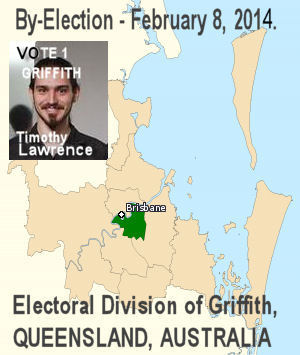
 Despite being officially launched in 2010, it's the 7th of September 2013 that will see the real birth of the 'population party'. William Bourke, the leader of the Party, says, "We champion a difficult but critical cause - misunderstood by some, and misrepresented by others. Despite the huge challenges of running a national campaign on a shoestring budget, our grassroots community party has collectively run an honorable and professional campaign. We have much to be proud of."
Despite being officially launched in 2010, it's the 7th of September 2013 that will see the real birth of the 'population party'. William Bourke, the leader of the Party, says, "We champion a difficult but critical cause - misunderstood by some, and misrepresented by others. Despite the huge challenges of running a national campaign on a shoestring budget, our grassroots community party has collectively run an honorable and professional campaign. We have much to be proud of."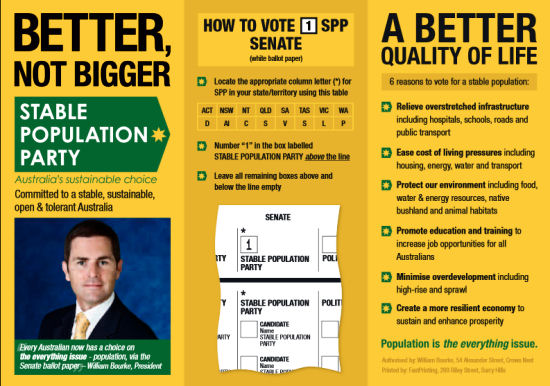
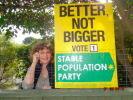
 Let’s ask why Greens, Liberals & Labor suppress the population issue: Stable Population Party - The party says it will reveal all in a front-page ad in the Sydney Morning Herald on Tuesday. The Stable Population Party points out that, despite a ‘massive thumbs down for big Australia’, [1] with 70 per cent hoping the population does not hit the 40 million mark projected by 2050, no major party will raise population as a campaign issue.
Let’s ask why Greens, Liberals & Labor suppress the population issue: Stable Population Party - The party says it will reveal all in a front-page ad in the Sydney Morning Herald on Tuesday. The Stable Population Party points out that, despite a ‘massive thumbs down for big Australia’, [1] with 70 per cent hoping the population does not hit the 40 million mark projected by 2050, no major party will raise population as a campaign issue. 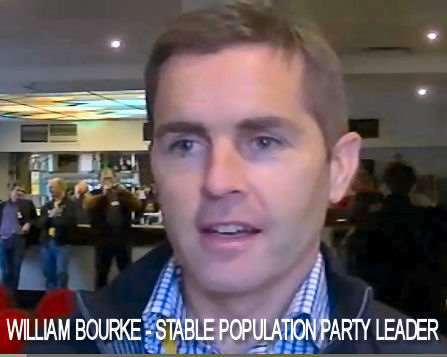

 Labor MP David Bradbury must correct error riddled conservation funding announcement (NSW), says Geoff Brown, Stable Population Party candidate. Mr Brown, who is a New South Wales natural conservation activist, has long fought to retain Cumberland plain woodland against attempts by governments to allow it to be destroyed for massive suburban developments. He believes now that the ALP has tried to take credit for his concept of the Cumberland Conservation Corridor. Geoff is running as a candidate for the Stable Population Party.
Labor MP David Bradbury must correct error riddled conservation funding announcement (NSW), says Geoff Brown, Stable Population Party candidate. Mr Brown, who is a New South Wales natural conservation activist, has long fought to retain Cumberland plain woodland against attempts by governments to allow it to be destroyed for massive suburban developments. He believes now that the ALP has tried to take credit for his concept of the Cumberland Conservation Corridor. Geoff is running as a candidate for the Stable Population Party.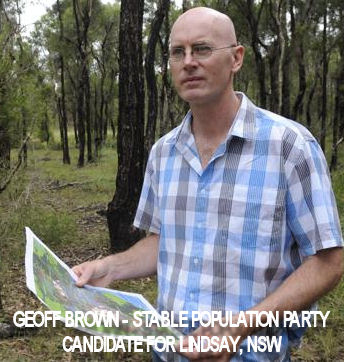 Mark Butler, the Federal Environment Minister, and David Bradbury, Labor member for Lindsay and the Assistant Treasurer, have been called on by Geoff Brown, the Stable Population Party candidate for Lindsay, to set the voters of Lindsay straight, after Lindsay's leading local newspaper, the Penrith Press, printed a half page story riddled with errors and misinformation about Labors 2010 federal election commitment of $7.5 million towards the establishment of the Cumberland Conservation Corridor.
Mark Butler, the Federal Environment Minister, and David Bradbury, Labor member for Lindsay and the Assistant Treasurer, have been called on by Geoff Brown, the Stable Population Party candidate for Lindsay, to set the voters of Lindsay straight, after Lindsay's leading local newspaper, the Penrith Press, printed a half page story riddled with errors and misinformation about Labors 2010 federal election commitment of $7.5 million towards the establishment of the Cumberland Conservation Corridor. 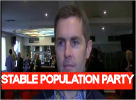 Reporting on the Australian elections by the ABC is Orwellian. If it sends chills down your spine then you will understand why candobetter.net is so keen to publicise political alternatives, especially any that promise a civilised halt to the overpopulation juggernaut to which Tony Abbot and Kevin Rudd have hitched their evil stars. This article promotes information about the candidate list for the Stable Population Party. The introduction was written by Sheila Newman, who has also filmed their Victorian candidates.
Reporting on the Australian elections by the ABC is Orwellian. If it sends chills down your spine then you will understand why candobetter.net is so keen to publicise political alternatives, especially any that promise a civilised halt to the overpopulation juggernaut to which Tony Abbot and Kevin Rudd have hitched their evil stars. This article promotes information about the candidate list for the Stable Population Party. The introduction was written by Sheila Newman, who has also filmed their Victorian candidates. This article features videos of the four Victorian based candidates for the Stable Population Party - Jill Quirk, Clifford Hayes, Michael Bayliss, Steven Armstrong and Jonathan Page - not necessarily in that order. It is very interesting to see what the candidates have to say and how they present. Australians have a chance of making a crucial difference by voting for these candidates in the Senate and in the lower house for the next Federal Election. Candidates are also running in other states. Check this website for details:
This article features videos of the four Victorian based candidates for the Stable Population Party - Jill Quirk, Clifford Hayes, Michael Bayliss, Steven Armstrong and Jonathan Page - not necessarily in that order. It is very interesting to see what the candidates have to say and how they present. Australians have a chance of making a crucial difference by voting for these candidates in the Senate and in the lower house for the next Federal Election. Candidates are also running in other states. Check this website for details:  Saturday 29 June 2013 was the Melbourne launch of the Stable Population Party Australia.
Saturday 29 June 2013 was the Melbourne launch of the Stable Population Party Australia.




 "Let me return to my old primary school, St Joseph's convent [in Cloncurry]. Saint Mary McKillop, I'm sure, was just like my principal, Sister Thomas..." Bob Katter's book, while retrieving some good Australian ideas and paying its respects to our ancestors, also markets big population ideas uncannily like those of B.A. Santamaria.
"Let me return to my old primary school, St Joseph's convent [in Cloncurry]. Saint Mary McKillop, I'm sure, was just like my principal, Sister Thomas..." Bob Katter's book, while retrieving some good Australian ideas and paying its respects to our ancestors, also markets big population ideas uncannily like those of B.A. Santamaria.

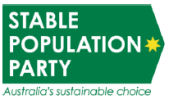
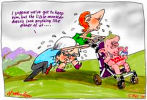 Limiting baby bonus payments to each woman’s first two children would mean that the majority of people with two or fewer children would not be subsidising those who choose to have larger families. It would also conservatively save over $2 billion in direct costs to taxpayers every year, not to mention hundreds of thousands of dollars in infrastructure for each new person. William Bourke speaks up about the changes to the Australian baby bonus. The Stable Population Party has been formally registered with the Australian Electoral Commission since 2010 and its website is
Limiting baby bonus payments to each woman’s first two children would mean that the majority of people with two or fewer children would not be subsidising those who choose to have larger families. It would also conservatively save over $2 billion in direct costs to taxpayers every year, not to mention hundreds of thousands of dollars in infrastructure for each new person. William Bourke speaks up about the changes to the Australian baby bonus. The Stable Population Party has been formally registered with the Australian Electoral Commission since 2010 and its website is 
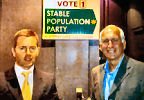 The Stable Population Party Australia is reaching out to members and sympathisers in a series of networking events across Australia. Should be interesting and fun to meet like-minded people and help to organise a coordinated electoral response to the growth lobby that has taken over our country. (Candobetter Ed.)
The Stable Population Party Australia is reaching out to members and sympathisers in a series of networking events across Australia. Should be interesting and fun to meet like-minded people and help to organise a coordinated electoral response to the growth lobby that has taken over our country. (Candobetter Ed.)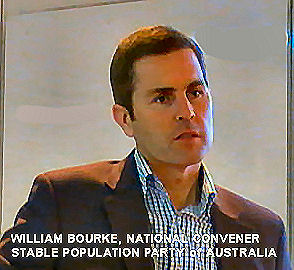
 12 March 2012, Sydney: New research released today by the Stable Population Party has found 73% of Australians would prefer a stable population of around 26 million by 2050; instead of Australia's current rate of growth which will see us exceed 36 million by 2050.
12 March 2012, Sydney: New research released today by the Stable Population Party has found 73% of Australians would prefer a stable population of around 26 million by 2050; instead of Australia's current rate of growth which will see us exceed 36 million by 2050. Stable Population Party Australia has finalised its core values and posted them to their website. In 2012 they say that they will be calling for new policy suggestions that align with these party values. Take a look...
Stable Population Party Australia has finalised its core values and posted them to their website. In 2012 they say that they will be calling for new policy suggestions that align with these party values. Take a look...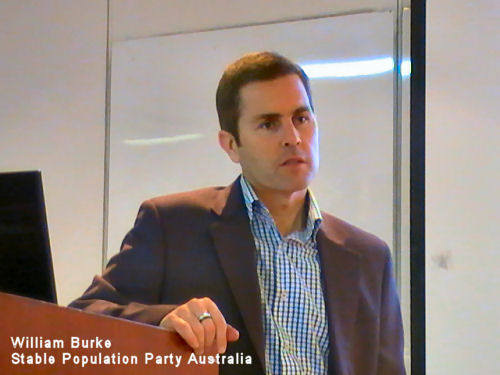


 SPA Population Film Festival - Brisbane Sunday 4 June 2011, Event supported by The Stable Population Party Australia. Details below.
SPA Population Film Festival - Brisbane Sunday 4 June 2011, Event supported by The Stable Population Party Australia. Details below.
 A corporate profiteering campaign has spread misinformation about a spurious need for increased skilled migration. Almost daily one hears big business representatives demand that Julia Gillard abandon her promise to dump Kevin Rudd’s “big Australia”. Instead they claim she must remove “red tape” and “increase the skilled migrant intake” to help clean up the disaster.
A corporate profiteering campaign has spread misinformation about a spurious need for increased skilled migration. Almost daily one hears big business representatives demand that Julia Gillard abandon her promise to dump Kevin Rudd’s “big Australia”. Instead they claim she must remove “red tape” and “increase the skilled migrant intake” to help clean up the disaster. 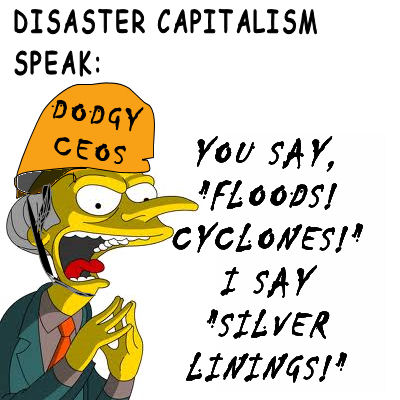
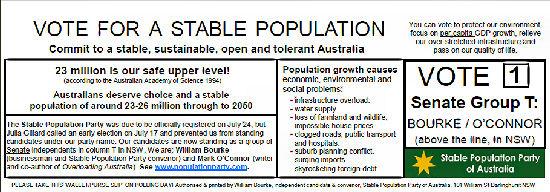
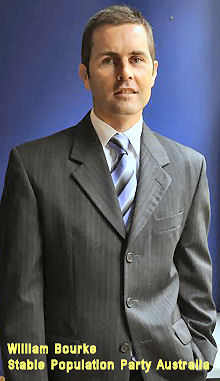 On Monday 17 May I interviewed William Bourke about himself and his party and his views on the politics of the current population debate. He described concerns about the impact of population numbers since the 1990s, but said that reading the book,
On Monday 17 May I interviewed William Bourke about himself and his party and his views on the politics of the current population debate. He described concerns about the impact of population numbers since the 1990s, but said that reading the book, 

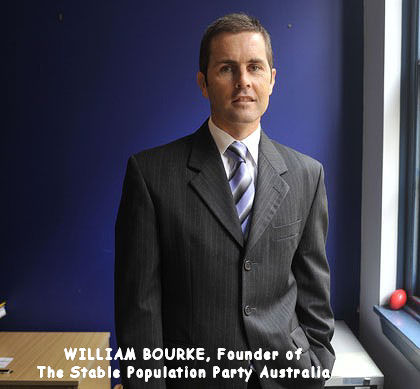
Recent comments